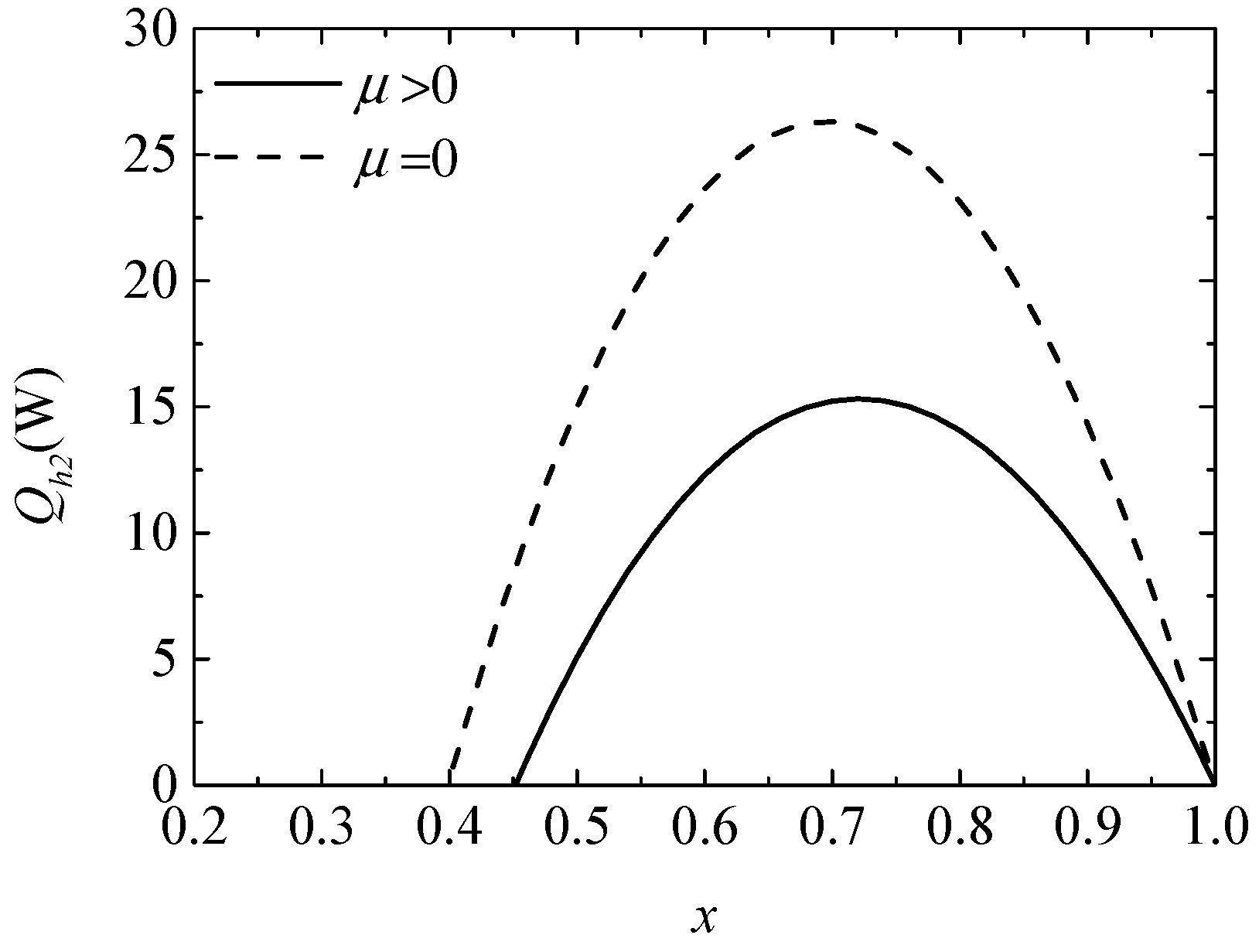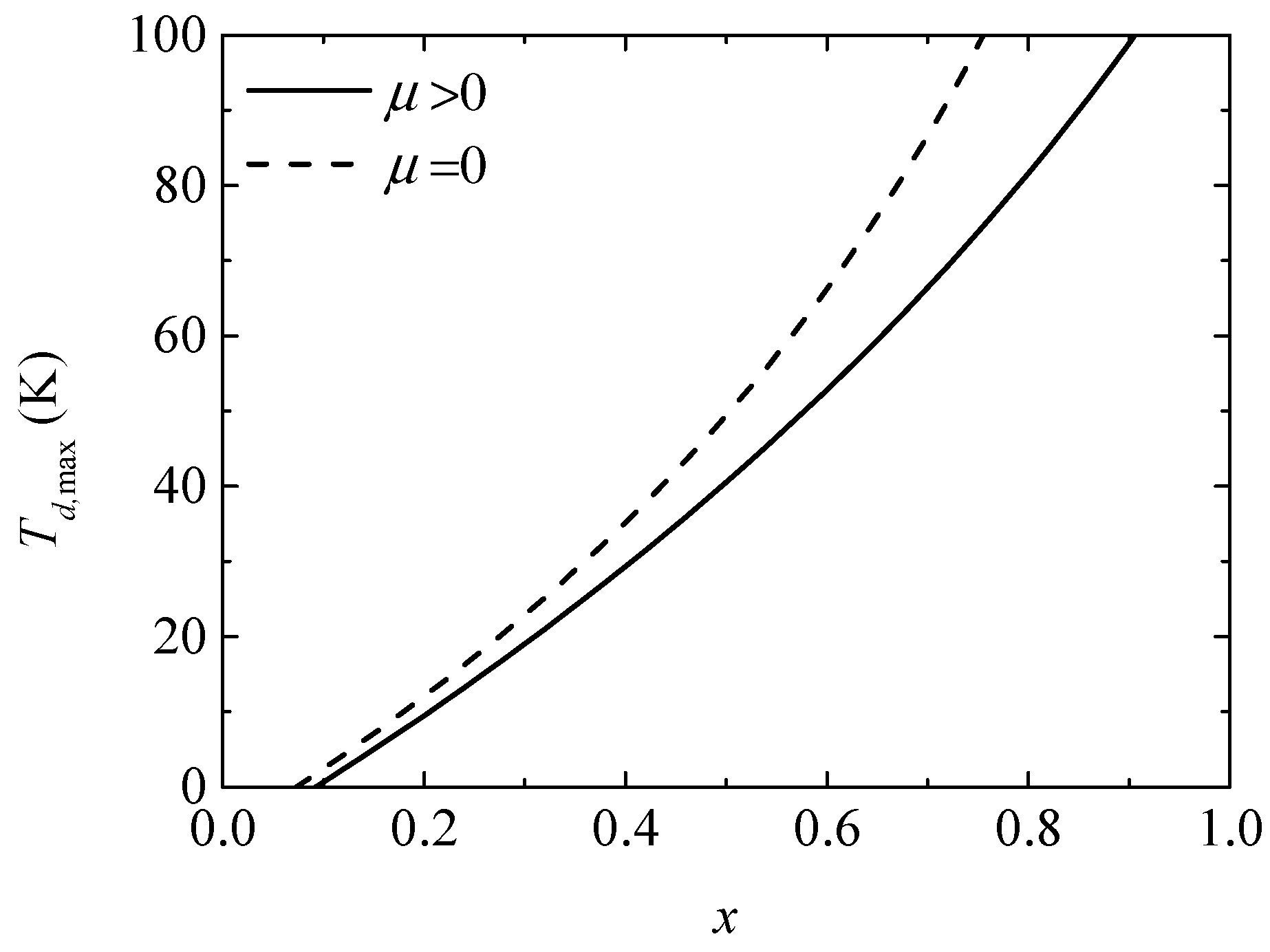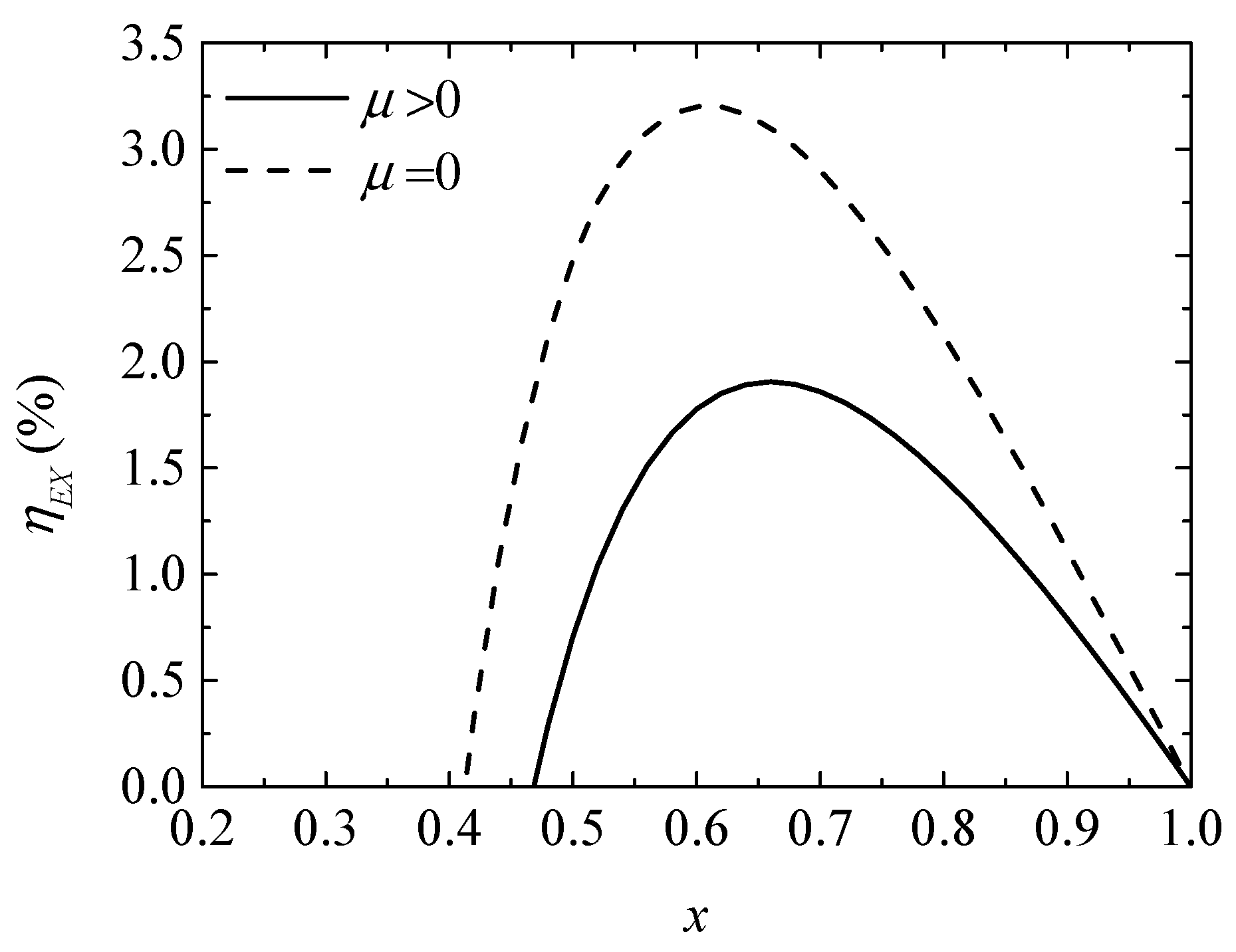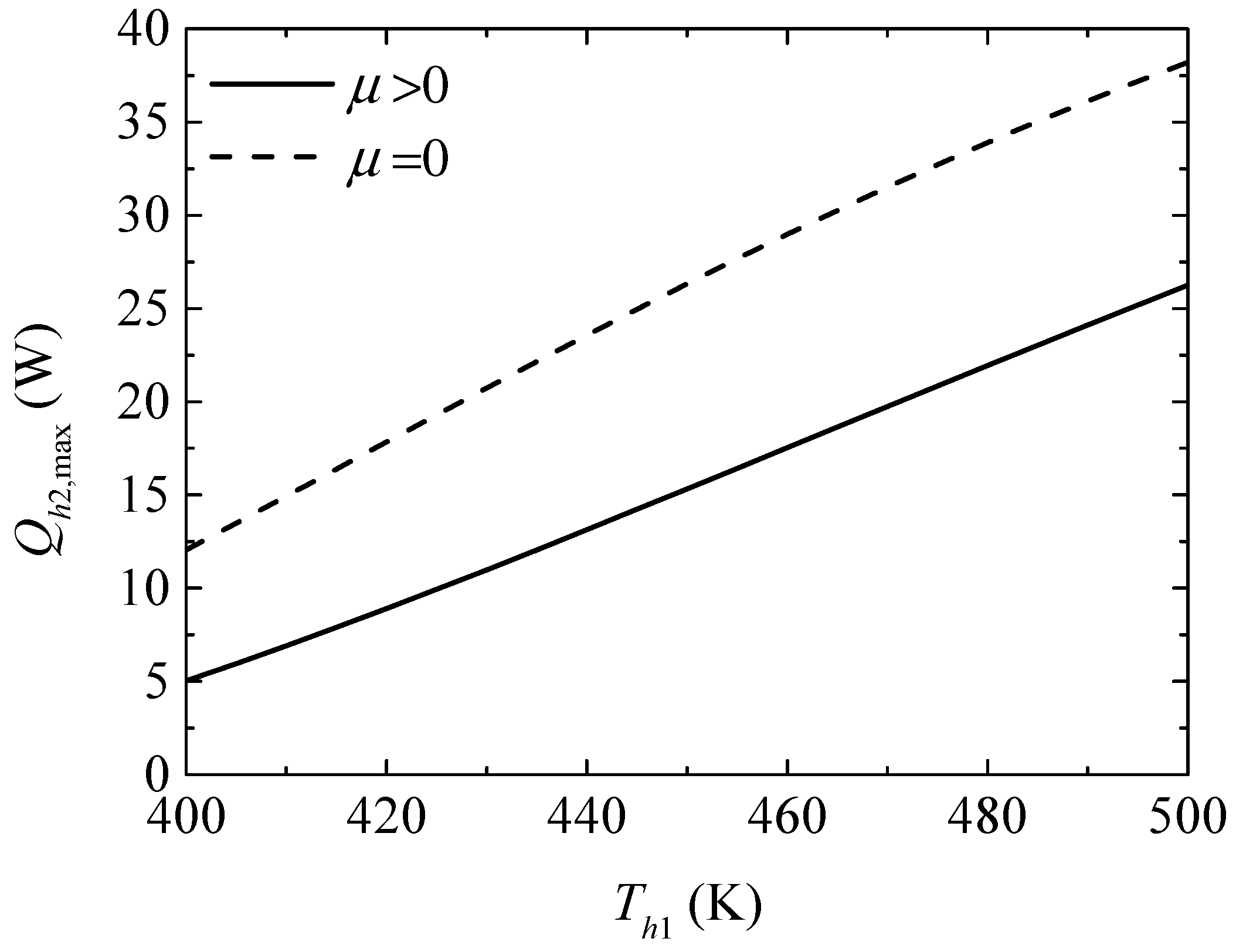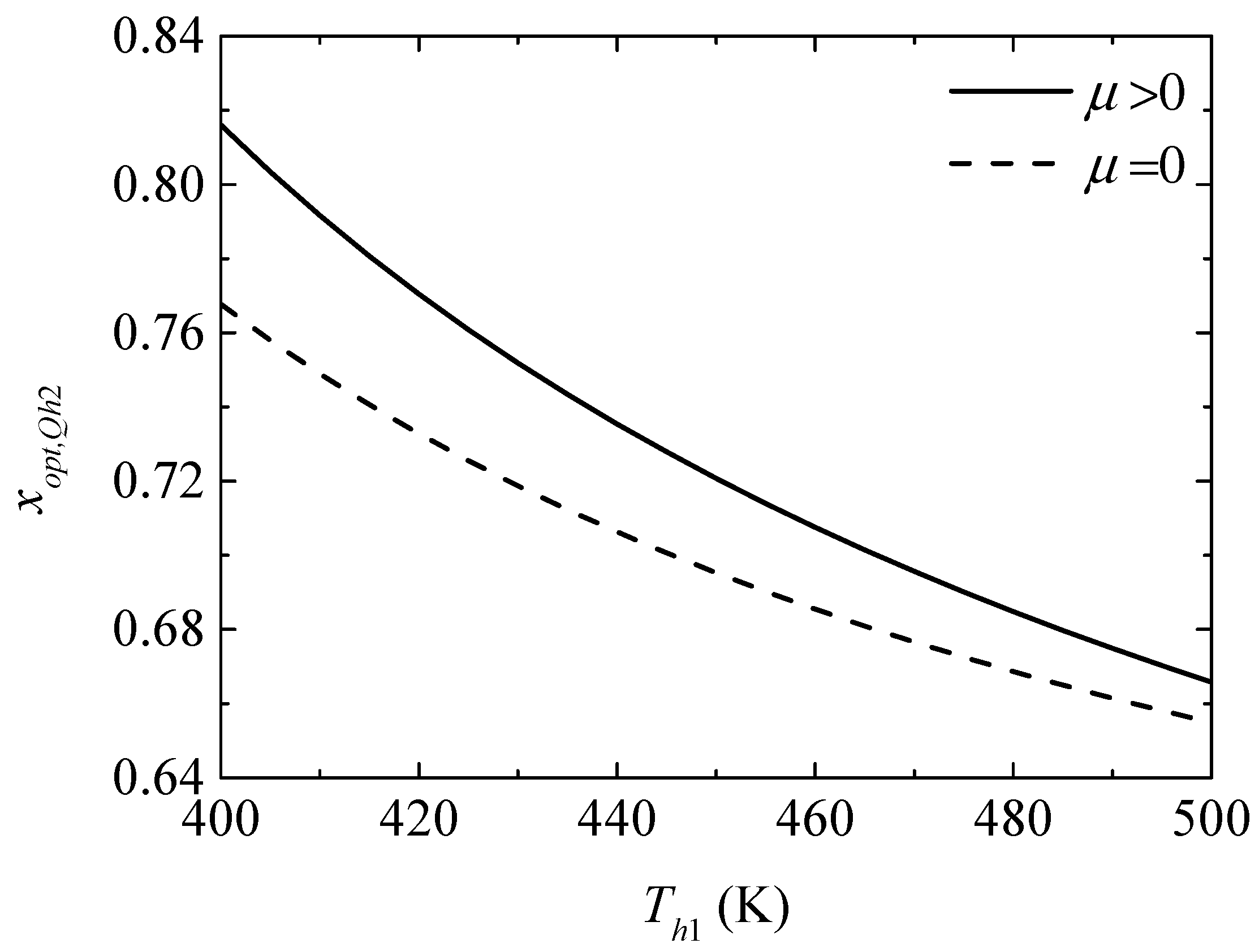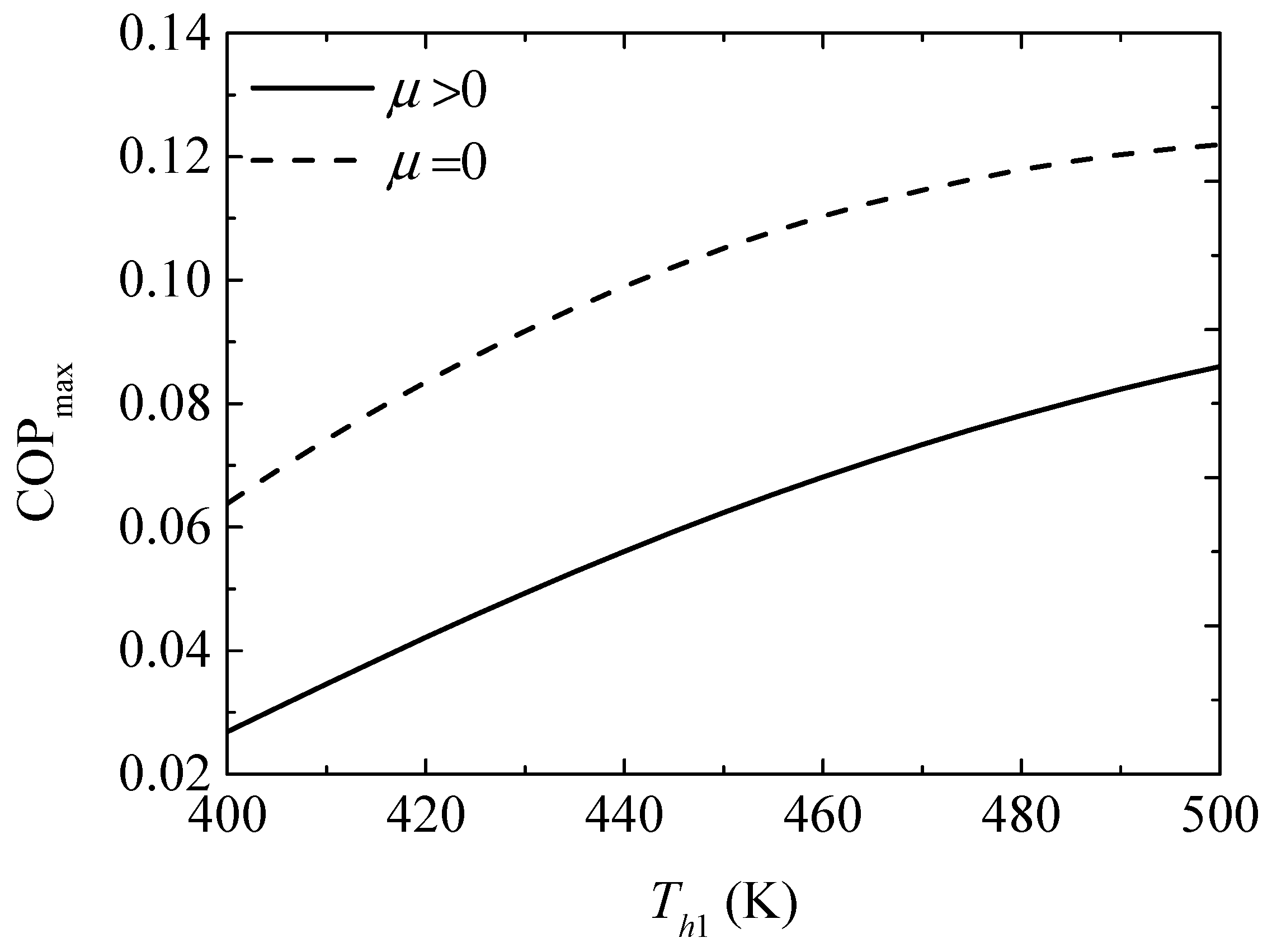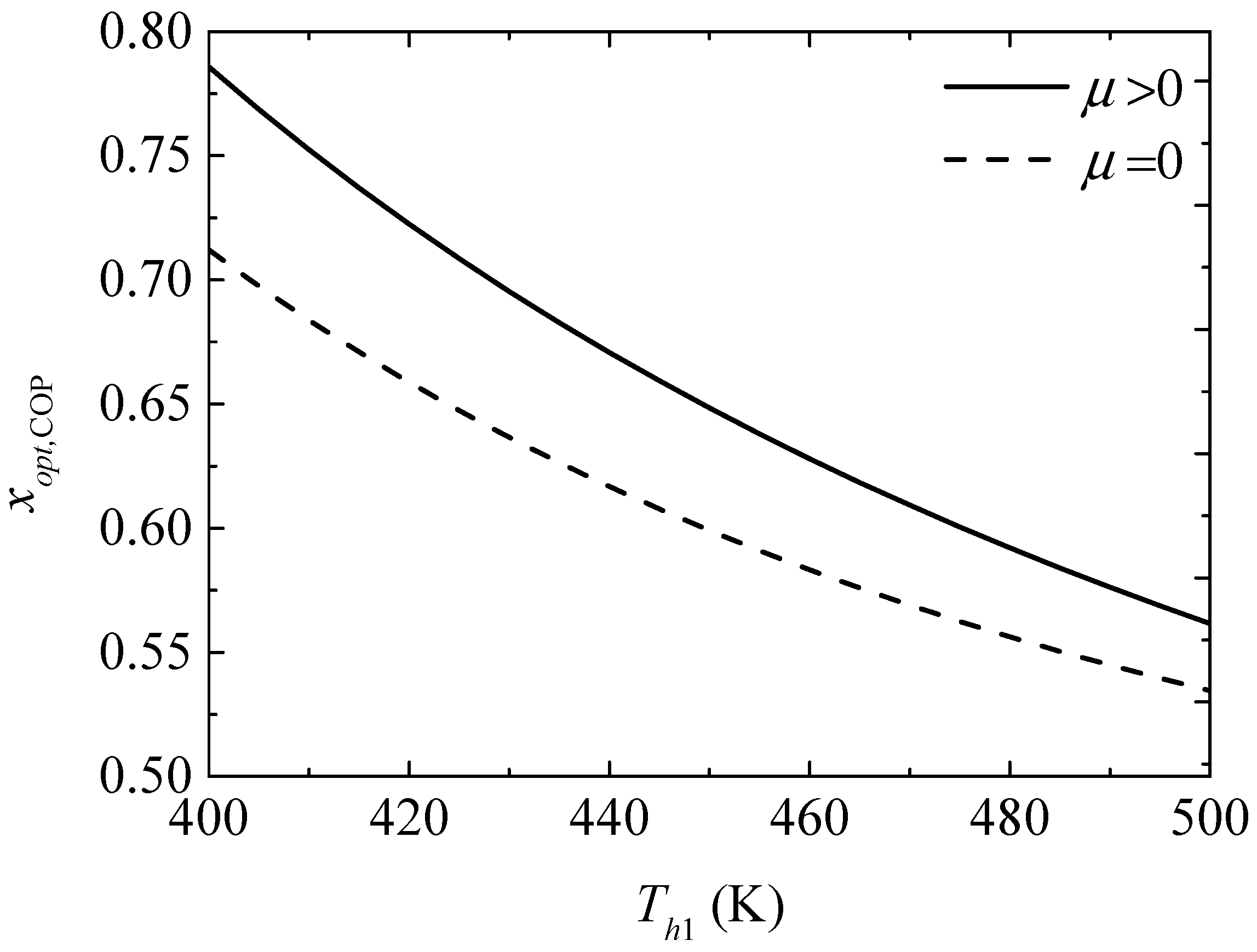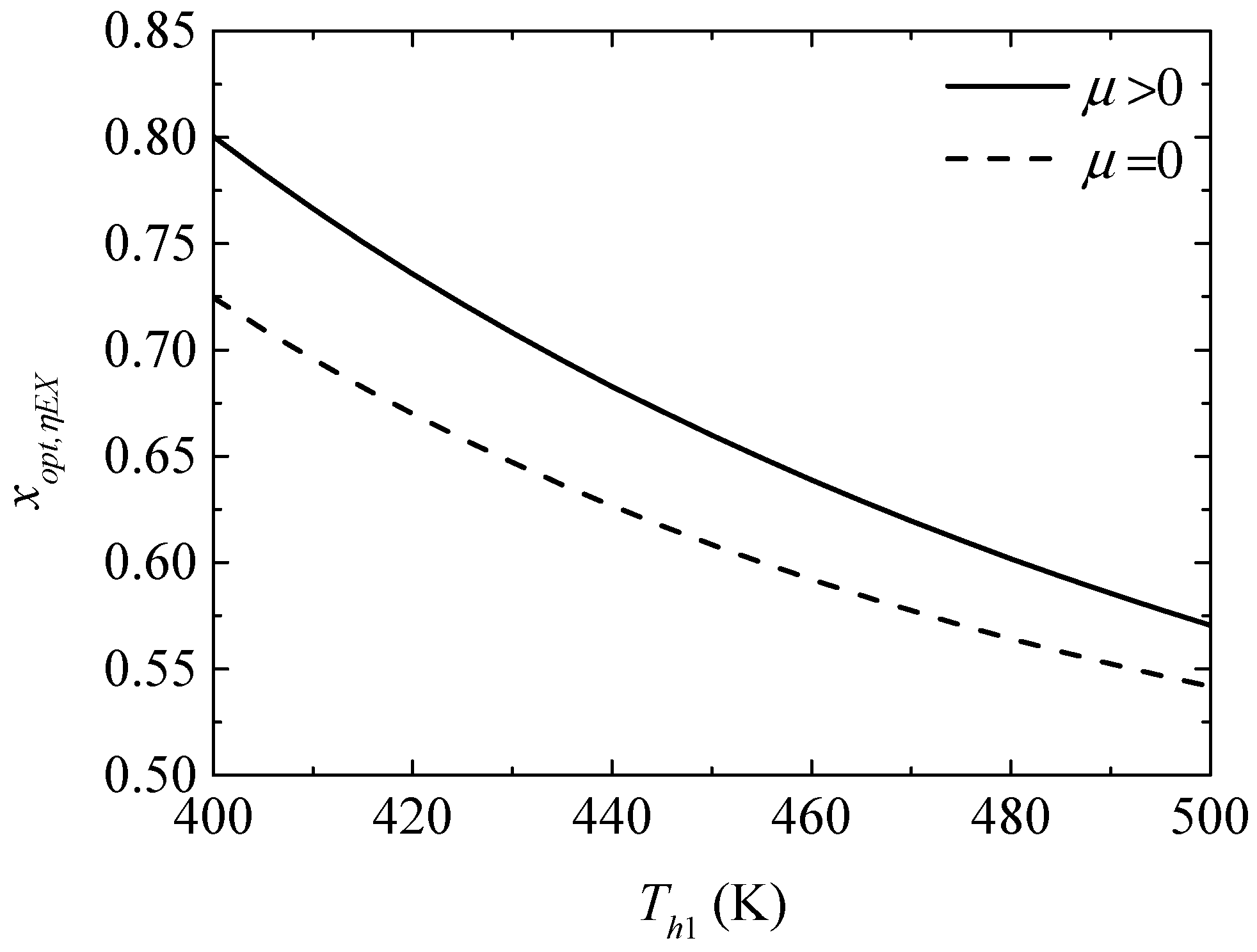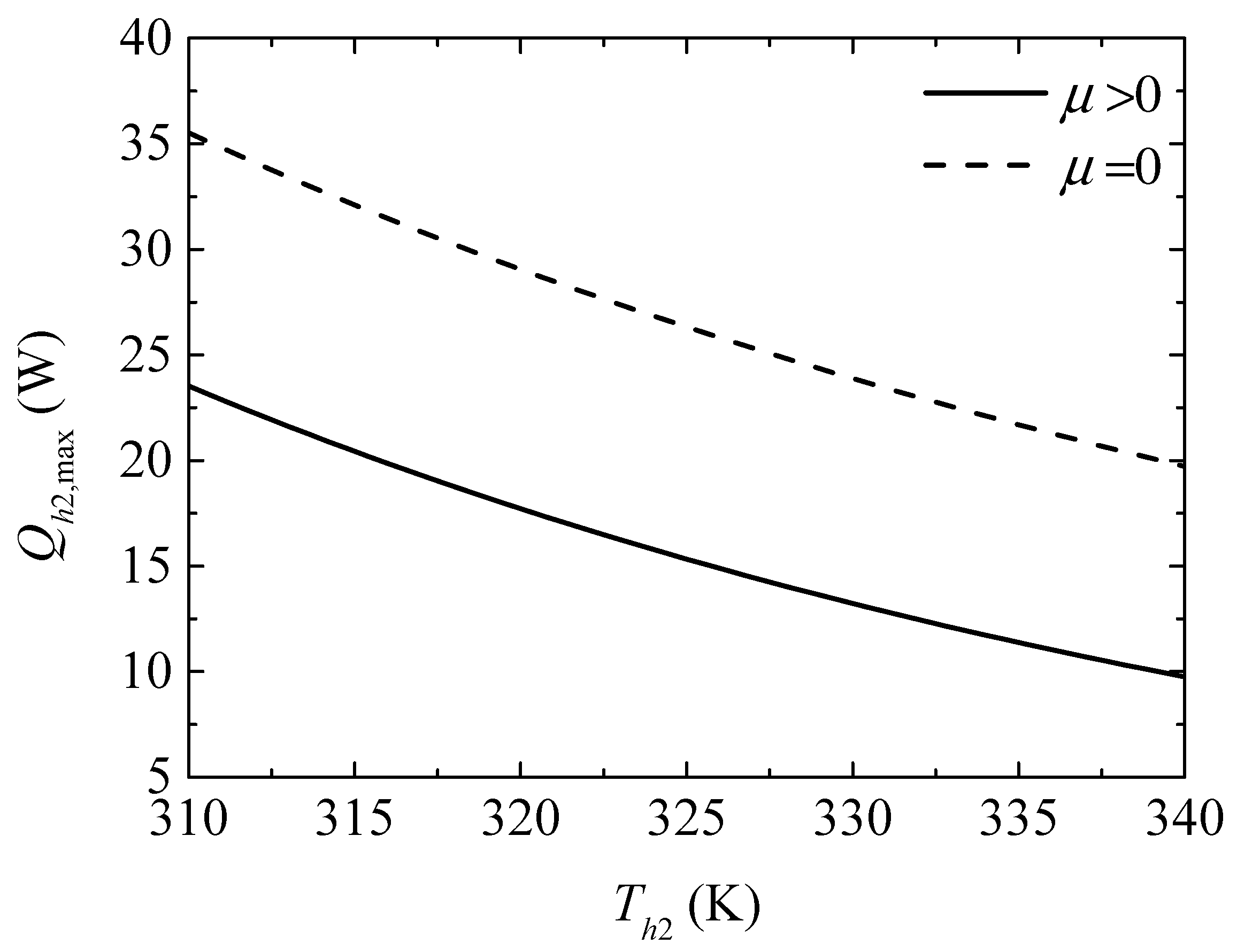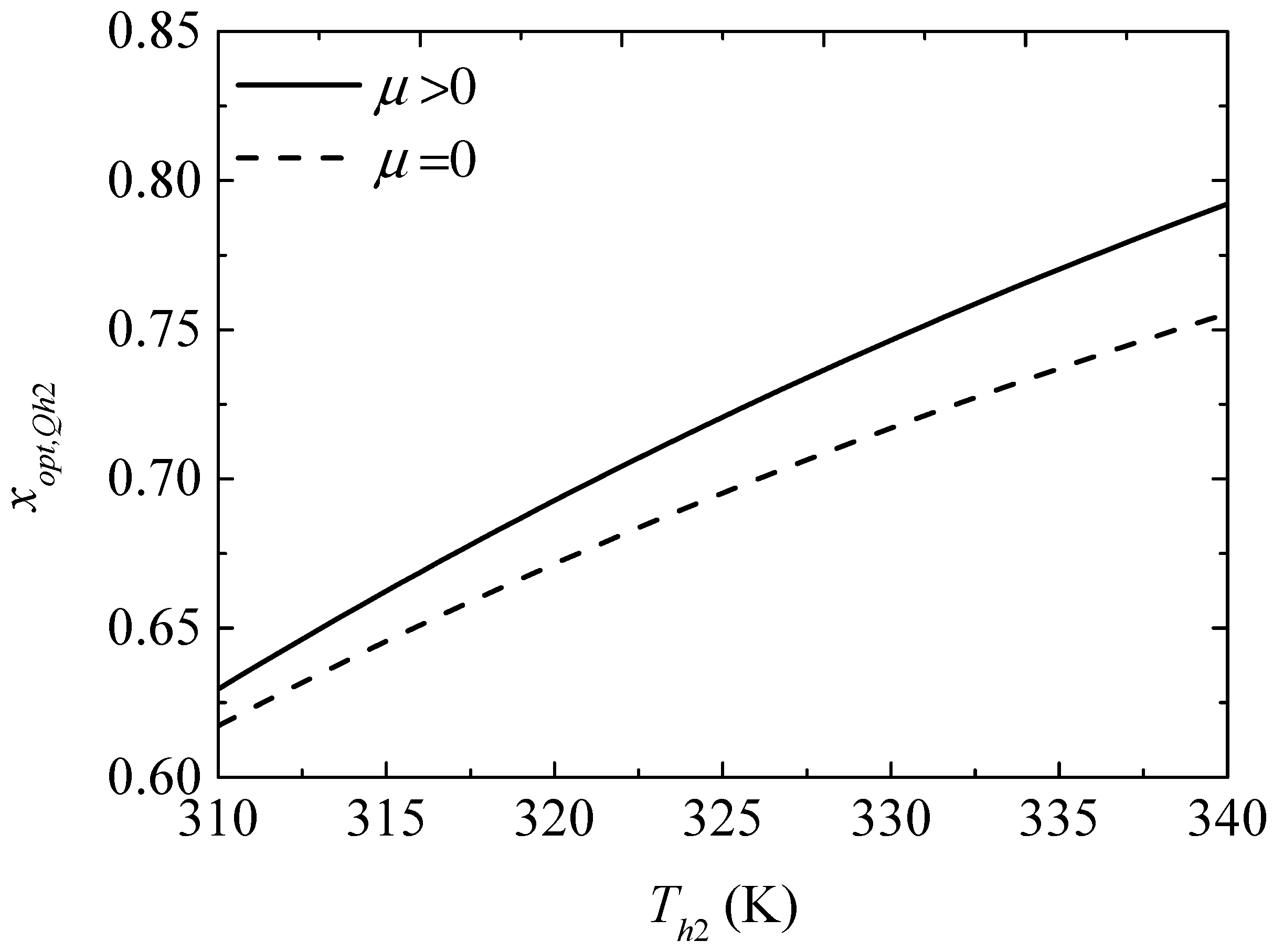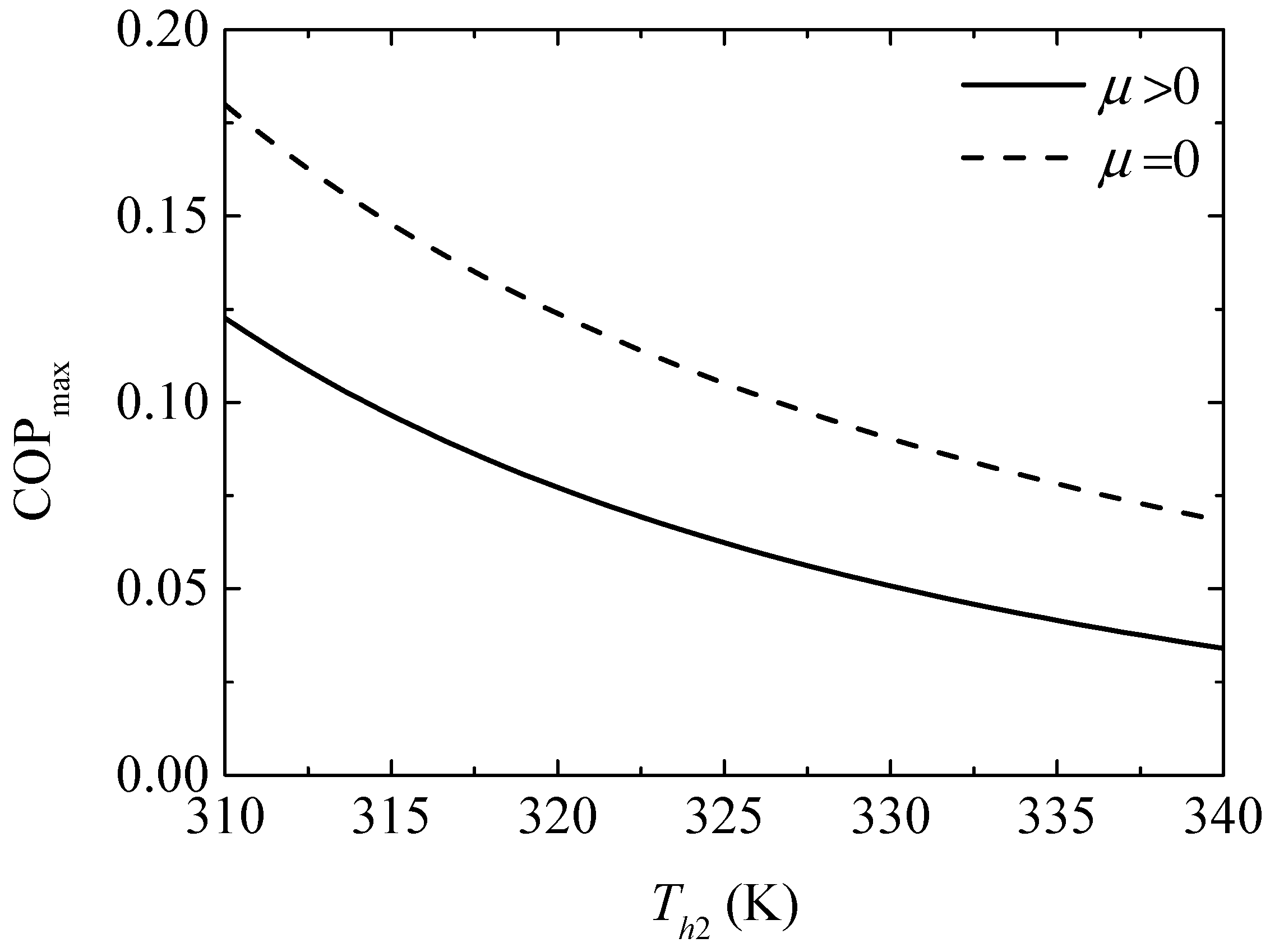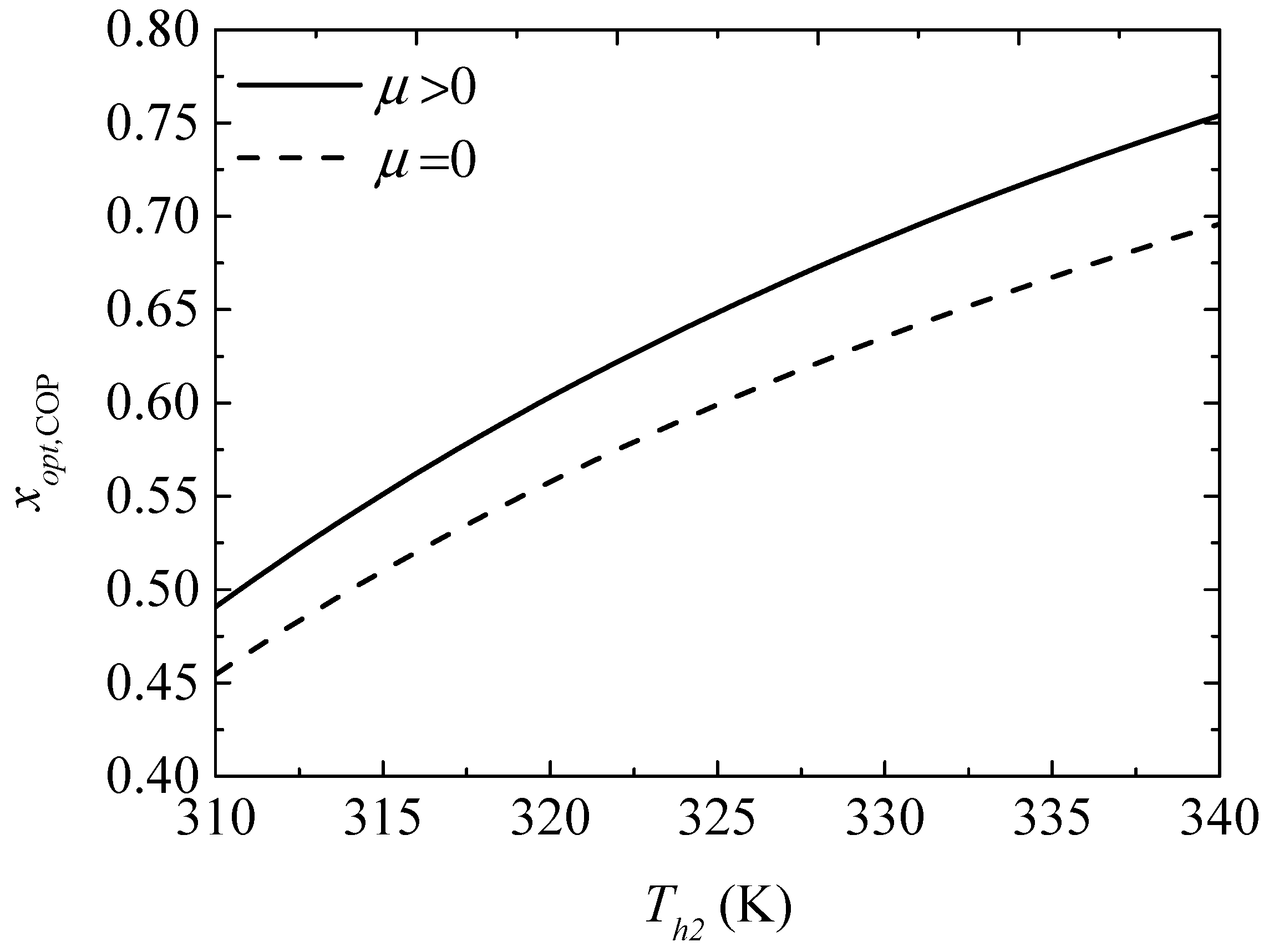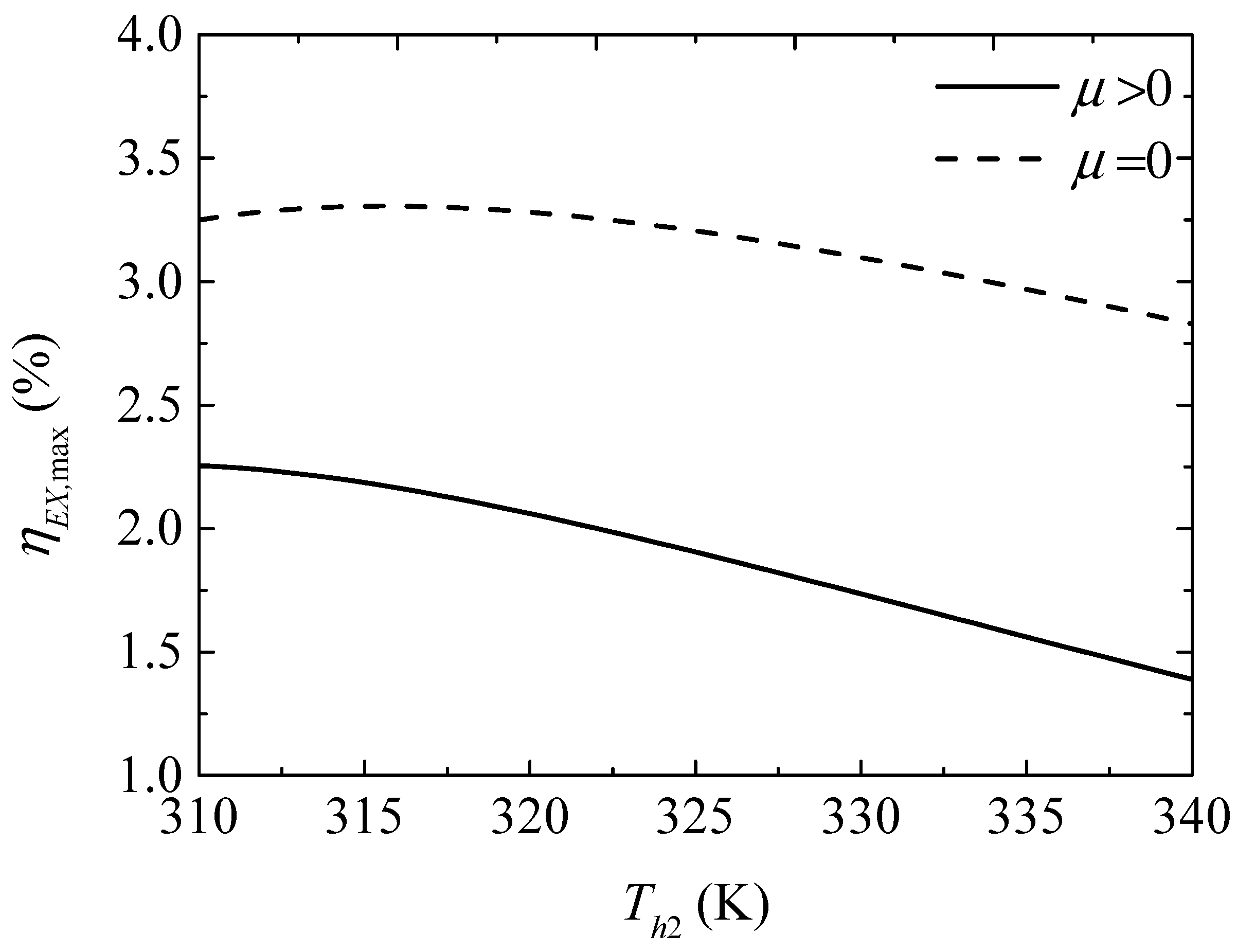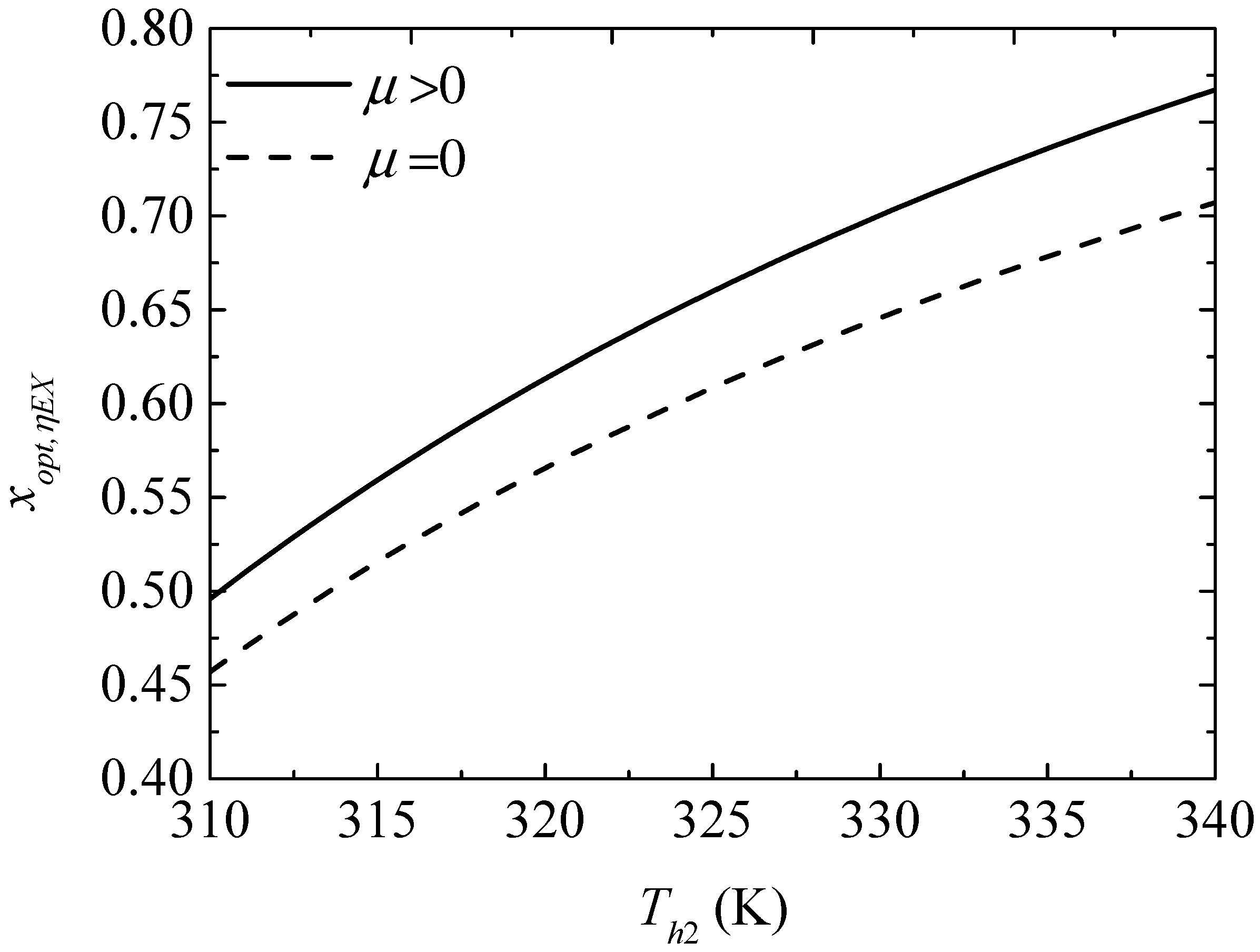1. Introduction
The thermoelectric (TE) effect [
1] can be used to directly convert between heat and electricity. It is the most effective way to realize power generation, cooling, and heating with zero emission [
2], and to utilize low-grade heat and to recycle waste heat [
3]. Traditional TE devices [
4] are categorized into TE generator (TEG), TE heat pump (TEH), and TE cooler (TEC). Combined TE devices, which are TEC- or TEH-driven by a TEG, are a new type of TE device. Due to its advantages of environmental protection, high reliability, no working medium, no extra power supply, and thermal insulation and saving on piping material, combined TE devices have unique values and potential for applications [
5].
Non-equilibrium thermodynamic theory [
6,
7,
8] is the basic theory to analyze the performance of TE devices. Some researchers have studied TEGs [
9,
10,
11,
12], TEHs [
13,
14,
15], TECs [
16,
17,
18,
19], and combined TE devices [
20,
21,
22,
23] based on non-equilibrium thermodynamics, and some meaningful results have been gained. Vella et al. [
20] proposed a TEG-driven TEC (TEG-TEC) combined device that uses solar energy as the heat source. Meng et al. [
21,
22,
23] proposed a TEG-driven TEH (TEG-TEH) combined device, analyzed the performance, optimized the allocation of the TE element [
21], investigated the maximum heating temperature difference of the TEG-TEH device [
22], and studied the effect of physical size of the TE element on the performance of the TEG-TEH device [
23].
The Thomson effect [
24,
25], which describes the heating or cooling when electrical current flows through a conductor with a temperature gradient, is one of the TE effects. The Thomson effect has been neglected in most thermodynamic studies on TE devices [
9,
10,
11,
12,
13,
14,
15,
16,
17,
18,
19,
20,
21,
22,
23]. However, some researchers have found that the Thomson effect has a notable influence on the performance of TE devices. Chen et al. [
26,
27] studied the Thomson heat in TEGs [
26] and TEHs [
27] and pointed out that the Thomson effect should be considered in thermodynamic studies of TE devices. Manikandan and Kaushik [
28,
29] and Lamba and Kaushik [
30] investigated the influence of the Thomson effect on the performances of TEGs [
28], TEHs [
29] and TECs [
30], and the results have indicated that the Thomson effect decreases the performances of TEGs and TEHs, and increases the performance of TECs. Ortega and Olivares-Robles [
31] studied the Thomson heat in two kinds of two-stage TECs with the same and different TE materials and found that the Thomson effect enhances performance slightly. Feng et al. [
32] studied the performance of a TEG-TEC combined device and the results indicate that the Thomson effect decreases the cooling capacity, coefficient of performance (COP), and maximum cooling temperature difference.
The exergy analytical method [
33,
34] is used to evaluate thermodynamic systems from the perspectives of quantity and quality, combining the first law with the second law of thermodynamics. Exergy efficiency [
35,
36], which is used to measure the efficiency of energy conversion of a thermodynamic system, is more comprehensive than the first law efficiency. Exergy losses can be pinpointed by means of an exergy analysis, so as to reduce the avoidable exergy losses by taking proper measures [
37,
38,
39,
40]. Sharma et al. [
41] performed exergy analysis for single and two-stage TECs and studied the effect of allocation of the TE element on exergy efficiency and exergy loss for two-stage TECs. Islam et al. [
42] performed exergy analysis for TEGs driven by solar energy. Nemati et al. [
43] optimized the length of the TE element of TEHs for maximum exergy and exergoeconomic performance. Manikandan and Kaushik [
28,
29] and Lamba and Kaushik [
30] carried out detailed energy analysis and exergy analysis for TEGs [
28], TEHs [
29], and TECs [
30], and studied the effect of shape parameters on exergy efficiencies.
The Seebeck coefficient, electrical resistance, thermal conductivity, and the Thomson coefficient of TE materials are temperature dependent. TE devices have been studied in the case of constant TE properties in many relevant literature in order to simplify the calculation process [
9,
10,
11,
12,
13,
14,
15,
16,
17,
18,
19,
20,
21,
22,
23]. Some researchers have performed thermodynamic studies on traditional TE devices in the case of temperature-dependent TE properties [
28,
29,
30,
44,
45,
46,
47,
48], and some practical results have been gained. Manikandan and Kaushik [
28,
29] and Lamba and Kaushik [
30] calculated the Seebeck coefficient, electrical resistance, thermal conductivity, and the Thomson coefficient of TEGs [
28], TEHs [
29], and TECs [
30] by fitting formulas. Meng et al. [
44] found that the temperature dependence of TE properties leads to more accurate calculated power output and thermal efficiency of TEGs. Feng et al. [
32] studied the TEG-TEC combined device with considering the temperature dependence of TE properties.
However, the influence of the Thomson effect on the performance of the TEG-TEH combined device has not been investigated so far. A non-equilibrium thermodynamic model of the TEG-TEH combined device, which considers the Thomson effect and the temperature dependence of TE properties, will be established in this paper using methods in References [
28,
29,
30] on the basis of studies in References [
21,
22,
23]. The performance characteristics will be analyzed. The allocation of TE elements will be optimized for a fixed total number of TE elements. The difference between the optimization results for the maximum exergy efficiency and for the maximum COP will be investigated. The influence of the Thomson effect on the general performance, optimal performance, and optimum variables will be investigated.
2. Physical Model and Basic Relations
Figure 1 shows a schematic diagram of a TEG-TEH combined device. The device consists of a TEG and a TEC connected in series; the TEG provides the input electric current (
) for the TEC. The TEG contains
pairs of TE elements and the two ends of the TEG are fixed on two heat conducting and insulating connection layers. The hot and cold junction temperatures of the TEG are
and
, respectively. The heat flow rates at the hot and cold junctions are
and
, respectively. The TEH contains
pairs of TE elements and the two ends of the TEH are fixed on two heat conducting and insulating connection layers. The hot and cold junction temperatures of TEH are
and
, respectively. The heat flow rates at the hot and cold junctions are
and
, respectively.
The following assumptions are made during modeling:
The TEG and TEH operate at steady state with constant junction temperatures;
The heat transfers through the TE elements are performed in a one-dimensional steady state along the TE leg;
The radiative and convective heat transfers around the TE elements are neglected since the modules are encapsulated adiabatically;
Joule heat and Thomson heat are distributed in TE elements evenly;
The Seebeck coefficient, electrical resistance, thermal conductivity, and the Thomson coefficient of the TE elements are dependent on temperature.
2.1. Energy Analysis
Based on the non-equilibrium thermodynamic theory, according to the modeling method in Reference [
49], the heat absorption rate at the hot junction and the heat release rate at the cold junction of the TEG are given by Equations (1) and (2):
The heat release rate at the hot junction and the heat absorption rate at the cold junction of the TEH are given by Equations (3) and (4):
where
is the Peltier heat flow rate,
is the Fourier heat flow rate,
is the Joule heat flow rate, and
is the Thomson heat flow rate. Parameters
,
,
,
, and
are the hot and cold junction Seebeck coefficients, total thermal conductance, total electrical resistance, and Thomson coefficients, respectively; subscripts 1 and 2 denote the TEG and TEH, respectively. Parameters
,
,
,
, and
are given by [
44]
where the subscripts
P and
N denote
P- and
N-type TE legs, respectively. Parameters
,
,
, and
are the thermal conductivity, electrical resistance, cross-sectional area, and length of the TE leg, respectively. Parameters
,
,
,
, and
are calculated similarly.
According to the balance of the heat flow in the system, one has
Substituting Equations (1)–(4) into Equation (10) gives the system stable electrical current:
The heating load, which is the heat flow rate release to heating space at the hot junction of the TEH, is given by Equation (3). The COP can be calculated as follows:
where the electric currents (
) in Equations (3) and (12) are determined by Equation (11).
The hot junction temperature of the TEH (
) reaches the maximum value when the heating load is zero [
22]. Therefore, substituting Equations (3) and (11) into
gives the maximum heating temperature as follows:
where
The maximum heating temperature difference can be expressed as
It can be seen from Equations (14) and (15) that is a function of the junction temperatures (, and ), TE element numbers ( and ), and physical properties.
2.2. Exergy Analysis
The exergy balance in the system is as follows:
where
is the rate of exergy input,
is the rate of exergy output,
is the rate of exergy loss, and
is the rate of exergy gain.
is zero because of the steady state operation. The rates of exergy input, output, and loss are given by
where
is the environment temperature.
According to the second law of thermodynamics, the exergy efficiency is given as follows:
can also be given by
where
, which is the entropy generation rate of the system, is given by
Substituting Equations (1)–(4) into Equation (21) or Equation (22), one can obtain the exergy efficiency
where
is determined by Equation (11).
Substituting
into the above equations, one can obtain the physical model and basic relations without considering the Thomson effect. Simplifying the physical property parameters further—that is, setting
,
, and
—the energy analysis becomes the results in References [
21,
22,
23]. Therefore, a more universal non-equilibrium thermodynamic model of the TEG-TEH combined device is established in this paper since it contains results from some available literature.
3. Numerical Examples
The heating load of the device increases with an increase in the number of TE elements according to Equation (3), but the TE element number is finite since the initial cost and space occupied by the device also increases with an increase in the number of TE elements. Therefore, the total TE element number () is fixed in the numerical examples. To describe the allocation of the TE element between the TEG and TEH, a design variable, the ratio of TE element number is defined as .
The physical property parameters and sizes of the
P- and
N-type TE legs of the device are assumed to be the same; namely,
,
,
,
,
,
,
,
,
,
,
, and
. The detailed parameters used in the calculations are presented in
Table 1.
Bismuth telluride (
) is used as the TE material in the numerical examples. The temperature-dependent properties of
P- and
N-type TE legs can be calculated by fitting the formulas provided by Xuan et al. [
50]
where
is the average temperature of the TE element. The average temperature of the TE element of the TEG is
, and the average temperature of the TE element of the TEH is
. According to the second Kelvin relation [
2], the Thomson coefficient is defined by
Combining Equations (24) and (27) gives the Thomson coefficients of
P- and
N-type TE legs
3.1. Performance Analyses
The hot junction temperatures of the TEG and TEH are set as and , respectively. Variations in the performance of the device with the ratio of the TE element number are studied with and without considering the Thomson effect.
Figure 2 gives the variation of heating load (
) with the ratio (
) of the TE element number. In
Figure 2 and the figures in the rest of this article, the solid and dashed lines represent the results with and without considering the Thomson effect, respectively. It is found that the variation of
presents a parabola-like shape. There exist an optimum
for the maximum
and a minimum
for the positive
. The Thomson effect decreases the
from 14.98 W to 5.067 W when
.
Figure 3 gives the variation of the maximum heating temperature difference (
) with the ratio (
) of the TE element number. It is found that
and the slope of the curve increase with an increase in
. The Thomson effect decreases
from 49.39 K to 40.53 K when
.
Figure 4 and
Figure 5 give the variations of the COP and exergy efficiency (
) with the ratio (
) of the TE element number, respectively. It is found that variations of COP and
present parabola-like shapes. Two optima
exist for the maximum COP and maximum
, respectively, and two minima
exist for the positive COP and positive
. The Thomson effect decreases the COP and
from 0.08683 and 2.480% to 0.03162 and 0.7073%, respectively, when
.
The optimum current () can be calculated through Equation (11) for a given optimum . The for maximum , maximum COP, and maximum considering the Thomson effect are 0.7172 A, 0.6321 A, and 0.6464 A, respectively. Those without considering the Thomson effect are 0.8780 A, 0.7252 A, and 0.7399 A, respectively. The electrical current reaches a maximum of 1.310 A in a short circuit condition. It can be seen that the maximum currents allowed by commercial TE modules can meet the requirements of optimal performance.
3.2. Performance Optimizations
According to the performance analyses, there are optimum structural designs that maximize the heating load, COP, and exergy efficiency of a TEG-TEH combined device, so performance optimizations are necessary. For optimizing the allocation of the TE element number for maximum heating load, maximum COP, and maximum exergy efficiency, the nomenclatures of the optimal performance and optimum
(
) obtained are listed in
Table 2.
The hot junction temperatures of the TEG and TEH, which determine the working surroundings, are important factors. Therefore, variations in the optimal performance and with hot junction temperatures of a TEG and TEH are studied with and without considering the Thomson effect in the performance optimizations.
The allocation of TE elements is optimized by solving non-linear integer programming since the TE element numbers ( and ) are integers. The curves of the optimal performances and versus the junction temperatures, which are discrete, are plotted as continuous curves to reflect the tendencies better. It has been proven by comparison that the difference between the discrete and continuous curves is small.
3.2.1. Effects of the TEG Hot Junction Temperature
Figure 6 gives the effect of the TEG hot junction temperature (
) on the maximum heating loads (
and
) with and without considering the Thomson effect when the TEH hot junction temperature is set at
.
Figure 7 gives the effect of
on the optimum ratios (
and
) of the TE element number at the maximum
. It can be seen from
Figure 6 that
and
increase with increasing
. The Thomson effect decreases the maximum
at different
. It can be seen from
Figure 7 that
,
, and the slopes of the curves decrease with increasing
. The Thomson effect increases the optimum
at the maximum
at different
.
Figure 8 gives the effect of the TEG hot junction temperature (
) on the maximum COPs (
and
) with and without considering the Thomson effect when the TEH hot junction temperature is set at
.
Figure 9 gives the effect of
on the optimum ratios (
and
) of the TE element number at the maximum COP. It can be seen from
Figure 8 that
and
increase and the slopes of the curves decrease with increasing
; a higher
leads to a gentle variation of
. That is, the maximum COP can be increased effectively by means of increasing
at lower
, but the method is not effective at higher
without considering the Thomson effect. The Thomson effect decreases the maximum COP at different
. It can be seen from
Figure 9 that
,
, and the slopes of the curves decrease with increasing
. The Thomson effect increases the optimum
at the maximum COP at different
.
Figure 10 gives the effect of the TEG hot junction temperature (
) on the maximum exergy efficiencies (
and
) with and without considering the Thomson effect when the TEH hot junction temperature is set at
.
Figure 11 gives the effect of
on the optimum ratios (
and
) of the TE element number at the maximum
. It can be seen from
Figure 10 that
increases at first and then decreases with increasing
;
increases and the slope of the curve decreases with increasing
; a higher
leads to a gentle variation of
. That is, the maximum
can be increased effectively by means of increasing
at a lower
, but the method is not effective considering the Thomson effect and even counterproductive without considering the Thomson effect at higher
. The Thomson effect decreases the maximum
at different
. It can be seen from
Figure 11 that
,
, and the slopes of the curves decrease with increasing
. The Thomson effect increases the optimum
at the maximum
at different
.
It can be concluded from
Figure 7,
Figure 9 and
Figure 11 that the Thomson effect increases the optimum
at different
. That is, due to considering the Thomson effect, more TE elements should be allocated to TEGs appropriately at different
to ensure the device is designed at the optimal performance. The optimum ratios of TE element number decrease with increasing
. That is, as
increases, more TE elements should be appropriately allocated to the TEH to ensure that the device is designed at the optimal performance.
3.2.2. Effects of the TEH Hot Junction Temperature
Figure 12 gives the effect of the TEH hot junction temperature (
) on the maximum heating powers (
and
) with and without considering the Thomson effect when the TEG hot junction temperature is set at
.
Figure 13 gives the effect of
on the optimum ratios (
and
) of the TE element number at the maximum
. It can be seen from
Figure 12 that
,
, and the slopes of the curves decrease with increasing
. The Thomson effect decreases the maximum
at different
. It can be seen from
Figure 13 that
and
increase and the slopes of the curves decrease with increasing
. The Thomson effect increases the optimum
at the maximum
at different
.
Figure 14 gives the effect of the TEH hot junction temperature (
) on the maximum COPs (
and
) with and without considering the Thomson effect when the TEG hot junction temperature is set at
.
Figure 15 gives the effect of
on the optimum ratios (
and
) of the TE element number at the maximum COP. It can be seen from
Figure 14 that
,
, and the slopes of the curves decrease with increasing
. The Thomson effect decreases the maximum COP at different
. It can be seen from
Figure 15 that
and
increase and the slopes of the curves decrease with increasing
. The Thomson effect increases the optimum
at the maximum COP at different
.
Figure 16 gives the effect of the TEH hot junction temperature (
) on the maximum exergy efficiencies (
and
) with and without considering the Thomson effect when the TEG hot junction temperature is set at
.
Figure 17 gives the effect of
on the optimum ratios (
and
) of the TE element number at the maximum
. It can be seen from
Figure 16 that
and
increase at first and then decrease with increasing
. The Thomson effect decreases the maximum
at different
. It can be seen from
Figure 17 that
and
increase and the slopes of the curves decrease with increasing
. The Thomson effect increases the optimum
at the maximum
at different
.
It can be concluded from
Figure 13,
Figure 15 and
Figure 17 that the Thomson effect increases the optimum
at different
. That is, due to considering the Thomson effect, more TE elements should be allocated to the TEG appropriately at different
to ensure that the device is designed at the optimal performance. The optimum ratios of the TE element number increase with increasing
. That is, as
increases, more TE elements should be allocated to the TEG appropriately to ensure that the device is designed at the optimal performance.
Comparing
Figure 9 with
Figure 11 and
Figure 15 with
Figure 17, it is found that the optimum
at the maximum
is greater than that at the maximum COP. That is, more TE elements should be appropriately allocated to the TEG for maximum
compared to that for the maximum COP.
3.2.3. The Ranges of Optimal Performance and Optimum Variables
A higher leads to a more efficient heating effect, while a higher COP or leads to more economical performance. So the TEG-TEH combined device should be designed with the best heating effect and the best economical performance (i.e., the optimal performance ranges that include the optimal ranges of , COP, and ).
Taking COP as an economical index, the optimal ranges of
, COP, and
—considering the Thomson effect—are
,
, and
, respectively. Those without considering the Thomson effect are
,
, and
, respectively.
Table 3 lists the optimization results for the maximum
, maximum COP, and maximum
when
and
are set. It is found that the Thomson effect narrows the optimal ranges of
, COP, and
.
It can be seen from
Table 3 and
Figure 9,
Figure 11,
Figure 15 and
Figure 17 that the optimum
at the maximum
is greater than that at the maximum COP. So,
should be set within the optimum
ranges, which are
and
with and without considering the Thomson effect, respectively, to ensure the device is designed within the optimal performance ranges. It can be concluded that the Thomson effect narrows the optimum
range.
The Thomson effect narrows the ranges of the optimal performance and optimum range and the optimal variables when is taken as the economical index.

